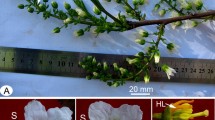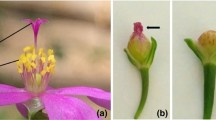Abstract
Dichogamy in Salicornieae species is not clearly described in literature, and its efficiency remains untested. In this work we aim to establish the pathway for flower development, the degree of interaction between the two sexes, and the efficiency in overcoming selfing. Flower development was studied in six populations of four Salicornieae species at the Odiel Marsh Natural Park (Huelva, SW Spain) by calculating the percentage of different floral phases established in accordance with the position of their stamens and stigmas. To study the sexual functionality of each phase, the lengths of the perianth, stigma, and ovule were measured, and the number of germinated pollen grains on the stigmas was counted. In the Arthrocnemum macrostachyum and Salicornia ramosissima populations, the stigma protrudes from the perianth when the anthers have shed their pollen. In the Sarcocornia fruticosa and Sarcocornia perennis populations, anthesis starts with the extrusion of one anther, but in the most common pattern the stigma protrudes from the perianth while the anthers are shedding their pollen. All species studied were morphologically protandrous, but only in one population of Arthrocnemum macrostachyum was the number of germinated pollen grains on the stigma significantly greater when the stigma was exserted than in the previous phases.





Similar content being viewed by others
References
Ball PW (1964) A taxonomic review of Salicornia in Europe. Feddes Repert 69:1–8
Ball PW, Tutin TG (1959) Notes on annual species of Salicornia in Britain. Watsonia 4:193–205
Bertin RI (1993) Incidence of monoecy and dichogamy in relation to self-fertilization in angiosperms. Am J Bot 80:557–583
Bertin RI, Newman CM (1993) Dichogamy in angiosperms. Bot Rev 59(2):112–152
Bhardwaj M, Eckert CG (2001) Functional analysis of synchronous dichogamy in flowering rush Butomus umbellatus (Butomaceae). Am J Bot 88(12):2204–2213
Castroviejo S, Coello P (1980) Datos cariológicos y taxonómicos sobre las Salicorniinae A J Scott ibéricas. Anal Jard Bot Madrid 37(l):41–73
Castroviejo S et al (1990) Chenopodiaceae. In: Castroviejo S (ed) Flora Ibérica, vol II. Real Jardín Botánico CSIC, Madrid, pp 476–553
Connor HE (1984) Gynodioecism in Sarcocornia quinqueflora (Salicornieae) in New Zealand. NZ J Bot 22:433–439
Cooke FW (1912) Observations on Salicornia australis. Trans NZ Inst 44:349–362
Cuguen J, Wattier R, Saumitou-Laprade P, Forcioli D, Mörchen M, Van Dijk H, Vernet P (1994) Gynodioecy and mitochondrial DNA polymorphism in natural populations of Beta vulgaris ssp. maritima. Genet Sel Evol 26:87–101
Dalby DH (1962) Chromosome number morphology and breeding behaviour in the British Salicorniae. Watsonia 5(3):150–162
Davy AJ, Bishop GF, Costa CSB (2001) Salicornia L. (Salicornia pusilla J. Woods, S. ramosissima J. Woods, S. europaea L., S. obscura P.W. Ball and Tutin, S. nitens P.W. Ball and Tutin, S. fragilis P.W. Ball and Tutin and S. dolichostachya Moss). J Ecol 89:681–707
Ferguson IK (1964) Notes on the stigma morphology and flowering behaviour in British Salicorniae. Watsonia 6(1):25–27
Fernández-Illescas F, Cabrera J, Nieva FJJ, Márquez-García B, Sánchez-Gullón E, Muñoz-Rodríguez AF (2010a) Production of aborted pollen in marsh species of Chenopodiaceae: evidence of partial male sterility in Suadeae and Salsoleae species. Plant Syst Evol 288(3–4):167–176
Fernández-Illescas F, Nieva FJJ, Muñoz AF (2010b) Pollen production in halophytic species of the Chenopodiaceae family in a Mediterranean marsh. Grana 49:300–307
Fernández-Illescas F, Nieva FJJ, Silva I, Tormo R, Muñoz AF (2010c) Pollen production of Chenopodiaceae species at habitat and landscape scale in Mediterranean salt marshes: an ecological and phenological study. Rev Palaeobot Palynol 161:127–136
Haines A (2000) Clarifying the taxonomy of Salicornia sensu lato of the northern United States. Bot Notes 2(Topsham USA):1–4. http://www.woodlotalt.com/publications/BotNotesv1n2.PDF. Accessed on 13 October 2007
Harder LD, Barrett SCH, Cole WW (2000) The mating consequences of sexual segregation within inflorescences of flowering plants. Proc R Soc Lond B 267:315–320
Jefferies RL, Gottlieb LD (1982) Genetic differentiation of the microspecies Salicornia europaea L. (sensu stricto) and S. ramosissima J. Woods. New Phytol 92:123–129
Jefferies RL, Davy AJ, Rudmik T (1981) Population biology of the salt marsh annual Salicornia europaea agg. J Ecol 69(1):17–31
Kadereit G, Mucina L, Freitag H (2006) Phylogeny of Salicornioideae (Chenopodiaceae): diversification biogeography and evolutionary trends in leaf and flower morphology. Taxon 55:617–642
Kadereit G, Ball P, Beer S, Mucina L, Sokoloff D, Teege P, Yaprak AE, Freitag H (2007) A taxonomic nightmare comes true: phylogeny and biogeography of glassworts (Salicornia L. Chenopodiaceae). Taxon 56:1143–1170
Kadereit G, Mavrodiev EV, Zacharias EH, Sukhorukov HP (2010) Molecular phylogeny of Atripliceae (Chenopodioideae, Chenopodiaceae): implications for systematics, biogeography, flower and fruit evolution, and the origin of C4 photosynthesis. Am J Bot 97:1664–1687
Knuth P (1909) Handbook of flower pollination, vol 3. Clarendon Press, Oxford
Lloyd DG, Webb CJ (1986) The avoidance of interference between the presentation of pollen and stigmas in angiosperms. I. Dichogamy. NZ J Bot 24:135–162
Lloyd DG, Yates JMA (1982) Intrasexual selection and the segregation of pollen and stigmas in hermaphrodite plants exemplified by Wahlenbergia albomarginata (Campanulaceae). Evolution 36:903–913
Lundqvist A, Osterbye U, Larsen K, Linde-Laursen I (1973) Complex self-incompatibility systems in Ranunculus acris L. and Beta vulgaris L. Hereditas 74:161–168
Luque T, Ruiz C, Avalos J, Calderón IL, Figueroa ME (1995) Detection and analysis of genetic variation in Salicornieae (Chenopodiaceae) using random amplified polymorphic DNA (RAPD) markers. Taxon 44:53–63
Moss CE (1954) The species of Arthrocnemum and Salicornia in Southern Africa. J S Afr Bot 20:1–22
Mulugeta D, Maxwell BD, Fay PK, Dyer WE (1994) Kochia (Kochia scoparia) pollen dispersion, viability and germination. Weed Sci 42:548–552
Navarro L (1997) Is the dichogamy of Salvia verbenaca (Lamiaceae) an effective barrier to self-fertilization? Plant Syst Evol 207:111–117
Noble SM, Davy AJ, Oliver RM (1992) Ribosomal DNA variation and population differentiation in Salicornia L. New Phytol 122:553–565
Packham JR, Willis AJ (1997) Ecology of dunes, saltmarsh and shingle. Chapman and Hall, London
Pandey KK (1960) Evolution of gametophytic and sporophytic systems of self-incompatibility in angiosperms. Evolution 14:98–115
Preston RE (1991) The intrafloral phenology of Streptanthus tortuosus (Brassicaceae). Am J Bot 78:1044–1053
Scott AJ (1978) Reinstatement and revision of Salicorniaceae J. Agardh (Caryophyllales). Bot J Linn Soc 75:357–374
Shamsutdinov ZS, Khamidov AA (1984) Flowering biology and the phenomenon of male sterility in Kochia prostrata (L.) Schrad. Probl Desert Dev 4:20–28
Soriano A (1947) Las quenopodiáceas de la tribu “Salicornieae” en la Republica Argentina. Rev Argentina Agronom 14:148–172
Stace CA (1997) New flora of the British Isles, 2nd edn. Cambridge University Press, Cambridge
Tölken HR (1967) The species of Arthrocnemum and Salicornia (Chenopodiaceae) in southern Africa. Bothalia 9:255–307
Valdés B (1987) Salicornia. In: Valdés B, Talavera S, Fernández-Galiano E (eds) Flora vascular de Andalucía occidental, vol I. Ketres, Barcelona, pp 184–185
Valdés B, Castroviejo S (1990) Salicornia. In: Castroviejo S (ed) Flora Ibérica, vol II. Real Jardín Botánico CSIC, Madrid, pp 531–534
Vanderpoorten A, Hardy OJ, Lambinon J, Raspé O (2010) Two reproductively isolated cytotypes and a swarm of highly inbred, disconnected populations: a glimpse into Salicornia’s evolutionary history and challenging taxonomy. J Evol Biol 24:630–644
Wilson PG (1980) A revision of the Australian species of Salicornieae (Chenopodiaceae). Nuytsia 3:3–154
Wolff SL, Jefferies RL (1987) Morphological and isozyme variation in Salicornia europaea (sl) (Chenopodiaceae) in northeastern North America. Can J Bot 65:1410–1419
Wyatt R (1983) Pollinator–plant interactions and the evolution of breeding systems. In: Real L (ed) Pollination biology. Academic Press, Orlando, pp 51–95
Zare G, Keshavarzi M (2007) Morphological study of Salicornieae (Chenopodiaceae) native to Iran. Pakistan J Biol Sci 10(6):852–860
Acknowledgments
We are grateful to the institution and staff of the Marismas del Odiel Natural Park, with special thanks to Enrique Sánchez-Gullón for his help and collaboration.
Author information
Authors and Affiliations
Corresponding author
Rights and permissions
About this article
Cite this article
Fernández-Illescas, F., Nieva, F.J.J., de las Heras, M.Á. et al. Dichogamy in Salicornieae species: establishment of floral sex phases and evaluation of their frequency and efficacy in four species. Plant Syst Evol 296, 255–264 (2011). https://doi.org/10.1007/s00606-011-0492-5
Received:
Accepted:
Published:
Issue Date:
DOI: https://doi.org/10.1007/s00606-011-0492-5




